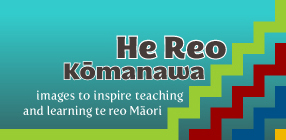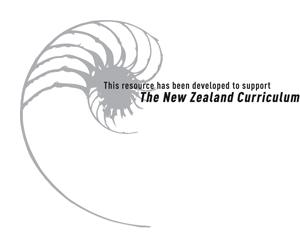
ImageTeaching and learning sequenceAdditional tasks and activities
Sample Task Sequence 2: Pāua
Image: Pāua (haliotis iris) shell


Copyright: Reproduced courtesy of the Museum of New Zealand Te Papa Tongarewa
Creator:
Identifiers: Museum of New Zealand Te Papa Tongarewa number I.005241. TLF resource R4695
Source: Museum of New Zealand Te Papa Tongarewa, http://www.tepapa.govt.nz
Students should be able to:
1.5 communicate about location;
2.3 communicate about likes and dislikes, giving reasons where appropriate;
2.5 communicate about physical characteristics, personality, and feelings.
Links to other learning areas
Science, the arts (visual arts)
Te reo Māori text
Ka kitea te pāua i te moana. Ko ngā toka i raro i te wai tōna kāinga. Ka nekeneke te pāua i runga i te toka ki te rapu kai. Ko te rimurimu te kai reka ki te pāua. He tino ātaahua te anga o te pāua. Nā tēnei, he pai te anga ki te mahi taonga kahurangi.
Statements: Kei te tika/Kāore i te tika
1. Ka nekeneke te pāua i runga i te moana.
2. Ko ngā toka i raro i te moana te kāinga o te pāua.
3. He reka te ika ki te pāua.
4. He ātaahua te kiko o te pāua.
5. Ka mahia he taonga kahurangi i te anga o te pāua.
Teaching and learning sequence
When appropriate, the teacher shares the intended learning outcomes with the students and negotiates success criteria with them. The teacher and students discuss these throughout the teaching and learning sequence.
1. Viewing of image
The students view the image: Pāua shell.
2. Pre-reading discussion
The students work in pairs or groups of four, discussing the image and sharing any information they know about pāua. If discussion in te reo Māori is beyond them, they could conduct their discussion mainly in English and simply make a word bank of relevant te reo Māori vocabulary. The teacher then leads a class discussion about pāua and its uses in the past and present. (For example, pāua can be used as a food, to create jewellery, and to embellish whakairo.)
The questions and discussion could be in te reo Māori and/or English. The teacher records key new te reo Māori vocabulary to create a class word bank.
3. Reading te reo Māori text
The students read the text silently, but are free to discuss any areas of difficulty in their pairs or small groups. If they are still unsure of some words after they have shared their ideas and tried to work out the new vocabulary, they may consult a dictionary. After the reading, the teacher encourages them to use a dictionary to confirm their guesses.
4. Teacher clarification
The teacher draws attention to new vocabulary and grammar and clarifies any remaining uncertainties.
5. Pair interactive task
In pairs, the students take turns to read the Kei te tika/Kāore i te tika statements. The listener says “Kei te tika” if the sentence is correct or “Kāore i te tika” if it is wrong. If it is wrong, the same student must correct the error. For example, Statement 2 is “Ka nekeneke te pāua i runga i te moana”. This statement is wrong, so the student says, “Kāore i te tika” and corrects the statement. The correction may be made in any of the following ways:
- by repeating the statement, but with the error corrected (for example, “Kāore te pāua e nekeneke i runga i te moana”);
- by using an appropriate sentence from the text (for example, “Ka nekeneke te pāua i runga i te toka”); or
- in the student’s own words (for example, “Ka noho te pāua i raro i te wai”).
When the students have completed the list of statements, they make up some Kei te tika/Kāore i te tika statements of their own for their partner to respond to. The ideas for these could come from their own knowledge and/or from the text.
6. Group mind mapping
Working in groups of four, the students make a mind map of what they collectively know about the pāua. This mind map is kept safe, as it will be used later, with additional information, in the presentation.
7. Inquiry
Facilitated by the teacher, the students discuss what other information they want to find out about pāua. Topics for the inquiry might include:
- Threats to pāua numbers
- The reasons for pāua being overfished
- Current measures to protect pāua
- New Zealand manufacturers and marketers of pāua jewellery
- Overseas manufacturers of New Zealand pāua jewellery and the effects of off-shore manufacture on local industries.
Each group forms a written question on which to focus their inquiry and then each student makes an inquiry plan that identifies how they will seek answers to their question. This might be through reading (using the library or Internet), museum visits, or interviewing whānau members or kaumātua. While the teacher provides support and oversight, the students undertake at least part of their inquiries for homework. They make written notes in which they record keywords and simple sentences in te reo Māori, and they bring these notes to school.
8. Addition of information to group mind maps
The class discusses the criteria for an effective mind map. Then, in their groups, the students pool the results of their inquiries and discuss how their findings can be incorporated into their group mind maps. This involves group discussion and the synthesis, prioritisation, and organisation of information. As the students work, the teacher circulates, helping with vocabulary and encouraging the students to kōrero Māori.
9. Presentation
The teacher selects a method of presentation, perhaps choosing from one of the five suggestions in this resource.
10. Reflection
The students are given 5–10 minutes to reflect individually on what they have learned from this cycle of learning. They record their reflections briefly in te reo Māori, listing the new vocabulary they learned and writing one new piece of information or new idea that they gained from their inquiry.
At this early level, teachers could offer the students a template for their reflections.
Additional tasks and activities
Depending on their students’ needs and interests, teachers may like to select from some of the following tasks and activities:
- Research and dramatise traditional or modern stories featuring pāua, with the dialogue including as much te reo Māori as possible.
- Describe the range of patterns and colours of anga pāua.
- Use watercolours or pastels to reproduce the beauty of anga pāua. Students then choose a partner’s best effort, describe it, and say why they like that design best.
- Design pāua jewellery.
- Design a sign, written in te reo Māori and accompanied by graphics, that informs divers of the regulations for harvesting pāua.


